Captain Alexander Beck Padilla

- Unit: 12th Fighter Bomber Squadron, 18th Fighter Bomber Group, 6002th Division Tactical Air Support Wing
- Service Number: 19106085, AO 556 092
- Date of Birth: January 21, 1923
- Entered the Military: June 11, 1942
- Date of Death: October 9, 1950
- Hometown: Tucson, Arizona
- Place of Death: near Kwangtan-Ni, North Korea
- Award(s): Purple Heart, Air Medal, Korean Service Medal, UN Service Medal, National Defense Service Medal, Korean Presidential Unit Citation, Republic of Korea War Service Medal
- Cemetery: Courts of the Missing, Court Eight. Honolulu Memorial, National Memorial Cemetery of the Pacific, Honolulu, Hawaiʻi
Cesar Chavez High School (Laveen, Arizona)
2024/2025
Early Life
Alexander Beck Padilla was born Alejandro Beck Padilla in Tucson, Arizona on January 21, 1923 to parents Felix Ochoa Padilla and Emma Beck. He was the oldest of three children. Felix supported the family by working as a clerk in a hardware store.
The family moved to Nogales, Arizona, about one hour south of Tucson. In 1941, Padilla graduated from Nogales High School. Before joining the military, he worked as a grocery clerk and a shoe salesman in Nogales.
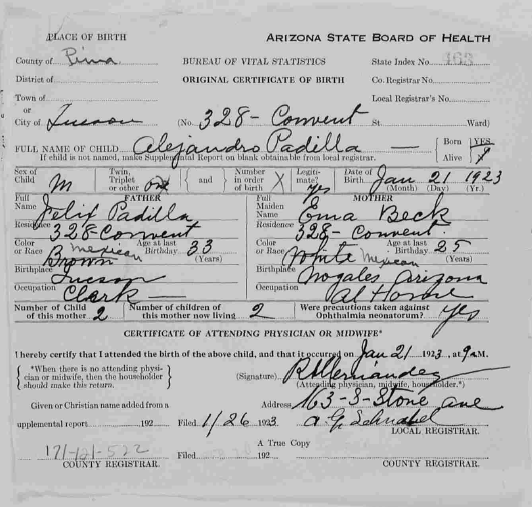


Homefront
Tucson is located in southern Arizona and is the state’s second-largest city. The Tucson metro area has a population of about one million people today.
In 1923, the year Alexander Beck Padilla was born, the population of Tucson was approximately 25,000. By the time he was declared Missing in Action in combat, Tucson had grown dramatically, transforming into a burgeoning metropolis with twice the population.
Tucson is a bilingual area and has always been home to many Hispanic-American families. Additionally, the Yaqui and Tohono O’odham tribes live there, which is the location of the San Xavier Indian Reservation.
Tucson is home to Davis-Monthan Air Force Base, which was established in 1925.
Padilla graduated from Nogales High School, but it is unclear when the family moved to that area. Nogales, Arizona, is a small town on the U.S.-Mexico border. In 1941, the population of Nogales was about 5,000 people.
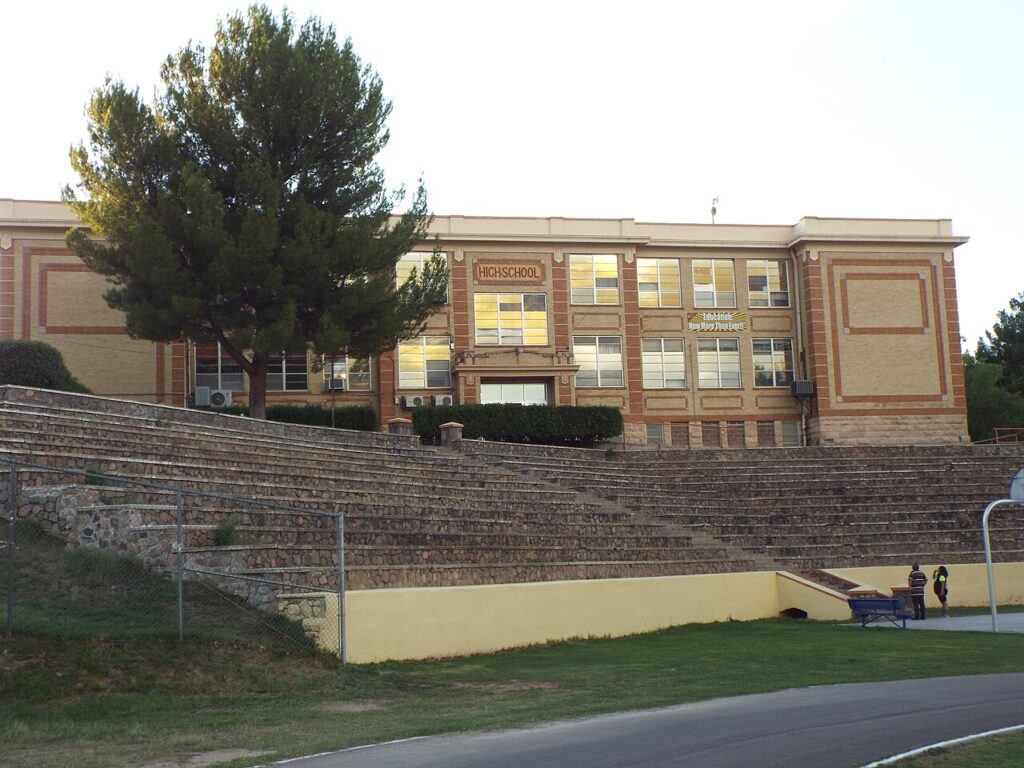
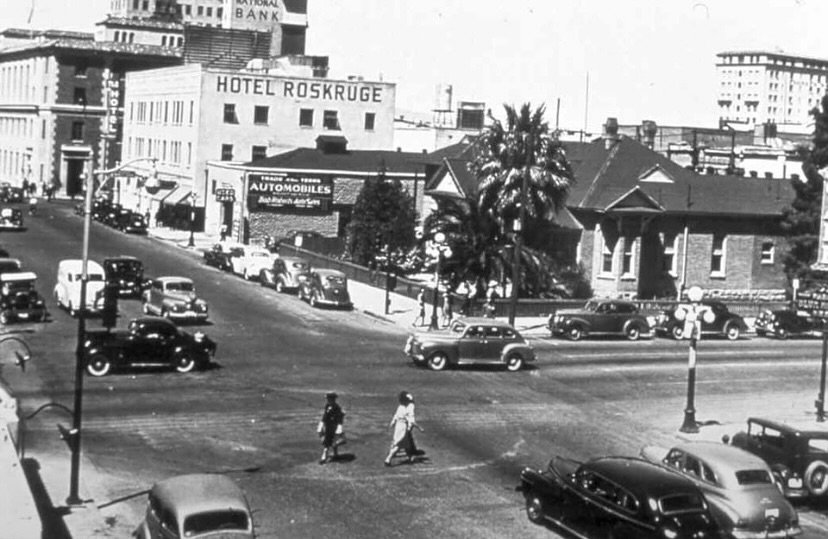
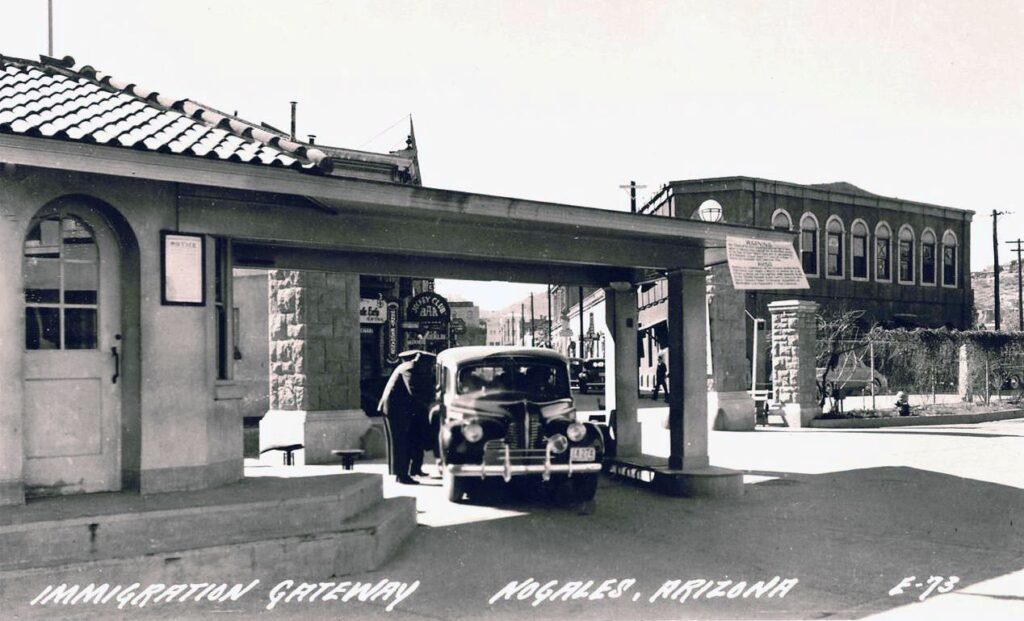
Military Experience
America declared war on the Axis Powers in December of 1941 as Alexander Beck Padilla was nearing graduation from high school. One year later, Padilla enlisted in the U.S. Army Air Corps to serve in World War II on July 11, 1942. He served in the Zone of Interior, which means he stayed stateside, where he received extensive pilot training.
In 1943, while enlisted, he married Evangeline C. Urrutia, also from Tucson.
Padilla was discharged from the U.S. Army Air Corps on October 11, 1945, to serve in the Officer Reserve Corps. During his time in the reserves, Padilla and his wife had two daughters, Dianne, born in 1944, and Mary Helen, who was born in 1948.
On September 21, 1948, he was called back up to active duty as part of the U.S. Air Force. He was stationed at Clark Air Force Base in the Philippines, where he remained until he was sent to Japan and then to South Korea in July 1950.
On October 9, 1950, Padilla and a squadron of F-51s took off from the Pusan East Air Base (K-9) in South Korea. The pilots headed out on an armed reconnaissance mission above the 38th parallel to a North Korean area about 15 miles outside of the city of Pyongyang. On route, the squadron noticed a large group of enemy trucks and attacked them. North Korean ground forces responded with anti-aircraft fire. In this exchange, Padilla’s plane was hit.
Another pilot reported that Padilla’s plane was on fire and leaking coolant. His fellow pilots attempted to communicate with him but received no reply. Padilla’s plane made a sharp turn and began to rapidly lose altitude. His plane continued its descent until it crashed in a rice paddy near the village of Kwangtan-Ni.
Other pilots circled the area where the plane crashed, and one of them noted that they saw Padilla exit the aircraft holding his arm, appearing dazed and in a state of shock. He waved to his fellow pilots circling overhead. Padilla proceeded to walk toward the village of Kwangtan-Ni but then seemed to realize continuing to the village was not a good idea. A fellow pilot reported that Padilla’s movements became erratic, and he sat down in a ditch.
Moments later, an enemy soldier from a nearby ravine began to fire in the injured airman’s direction. Padilla was then seen with his arms raised in surrender. His fellow squadron members did not want to shoot for fear that more enemy combatants were hidden in the area. They were concerned that the North Koreans would begin to fire directly at Padilla or at their planes.
At age 27, First Lieutenant Padilla was taken as a Prisoner of War and was seen being marched into the nearby village. Sadly, Captain Padilla was never heard from again. According to evidence gathered through the questioning of returned Prisoners of War, it is believed that Padilla and other soldiers were transported deeper into North Korea, where they subsequently died. No specific details have been released, and no further information has emerged.

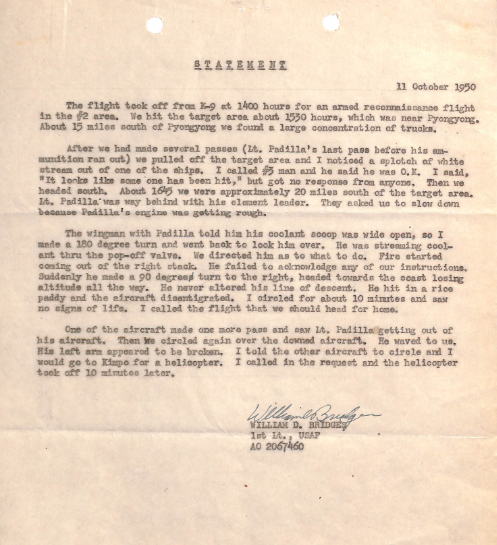
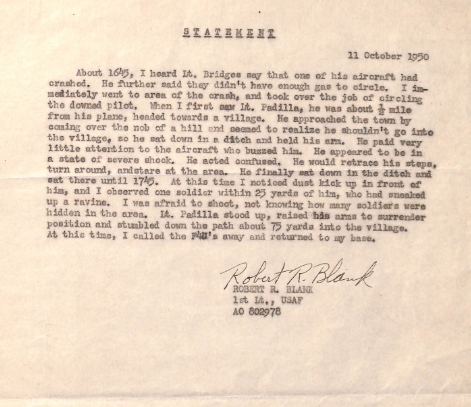
Commemoration
On September 8, 1951, First Lieutenant Padilla was promoted posthumously to the rank of captain.
After the war in 1953, North Korea allowed the U.S. inside the demilitarized zone for 45 days to conduct search and rescue; however, few remains were found. Once the time expired on the agreement, it was not renewed, so no further searches have been conducted.
In 1954, the North Koreans agreed to disinter American servicemembers and send them home. While the U.S. military was not involved in the disinterment process, the U.S. received approximately 4,000 sets of remains.
On March 31, 1954, Captain Alexander Padilla was pronounced dead by the military. However, hope continues that his remains will be brought back home to his family and given a proper burial.
In 2018, President Donald Trump negotiated with North Korean Leader Kim Jung Un to repatriate 55 boxes of human remains; to date, 100 soldiers have been identified from those remains. Unfortunately, Captain Padilla’s remains have not yet been identified.
Today, Captain Alexander Beck Padilla is memorialized on Court Eight of the Courts of the Missing at the Honolulu Memorial at the National Memorial Cemetery of the Pacific in Honolulu, Hawaiʻi. Captain Padilla’s name is also recorded at the Korean War Veterans Memorial in Washington, D.C.
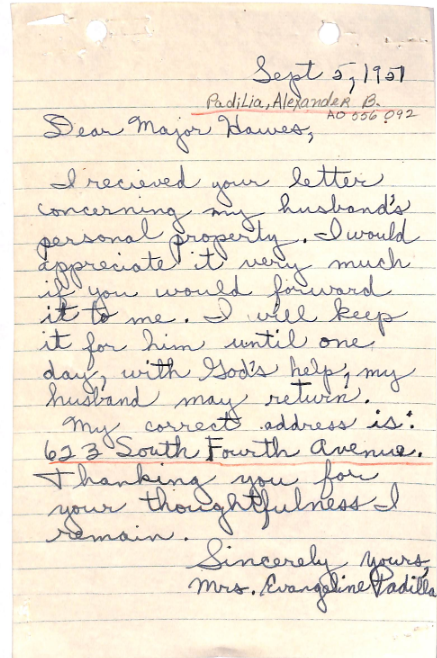
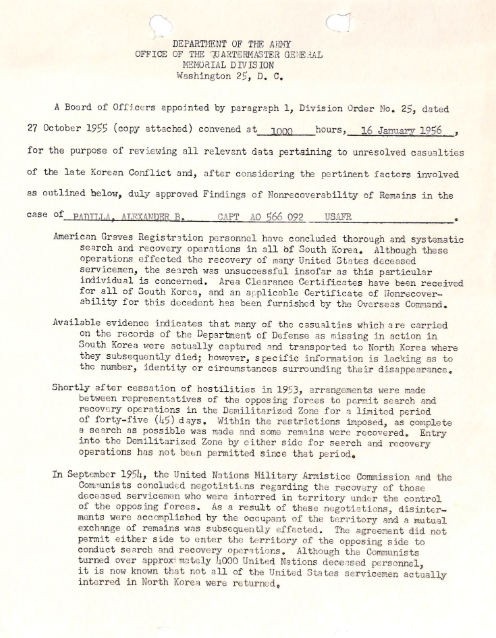
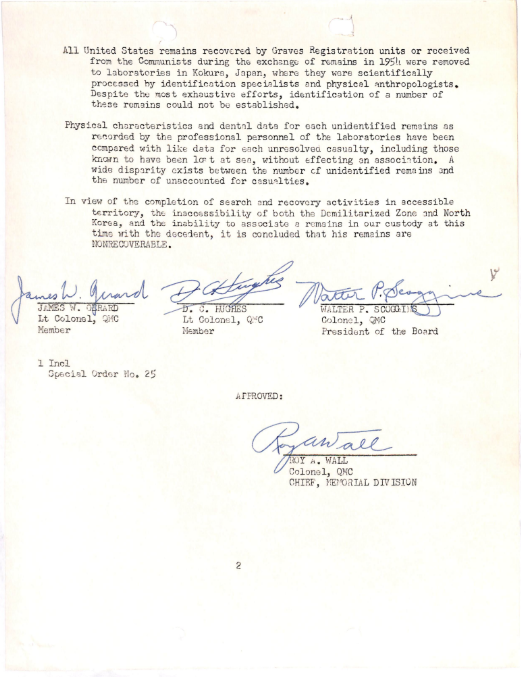
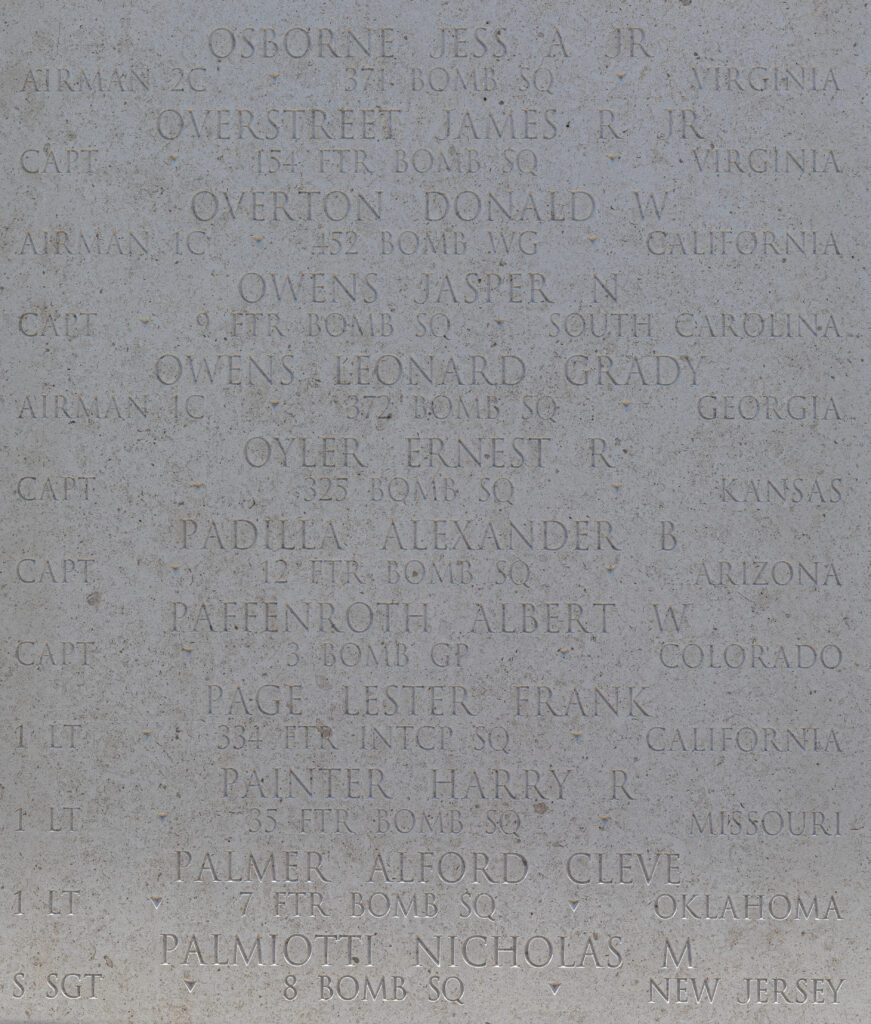
Bibliography
Primary Sources
Alejandro Padilla. Arizona, U.S., Birth Certificates, 1880-1935. Digital image. https://familysearch.org.
Alexander Beck Padilla, Final Pay Voucher. National Archives and Records Administration – St. Louis.
Alexander Beck Padilla. Individual Deceased Personnel File. National Archives and Records Administration – St. Louis.
Alexander Beck Padilla. U.S., World War II Army Enlistment Records, 1938-1946. National Archives and Records Administration. https://aad.archives.gov/aad/record-detail.jsp?dt=893&mtch=1&cat=all&tf=F&q=alexander%2Bpadilla&bc=&rpp=10&pg=1&rid=1742049.
Arizona. Pima County. 1930 U.S. Federal Census. Digital images. https://familysearch.org.
Arizona. Santa Cruz County. 1940 U.S. Federal Census. Digital images. https://familysearch.org.
Broadway and Sixth Avenues, Tucson, Arizona. Photograph. 1940s. Historic Tucson.
Immigration Gateway Nogales, Arizona. Postcard. Arizona Daily Star.
North American F-51D ‘Mustang.’ Photograph. Minnesota Air National Guard Museum. Accessed March 28, 2025. https://mnangmuseum.org/north-american-f-51d-mustang.
Nogales High School. Photograph. 2019. Wikimedia Commons. https://commons.wikimedia.org/wiki/File:Nogales-School-Nogales_High_School-1917.jpg.
“Tucson Officer Listed Missing.” Tucson Citizen [Tuscon, AZ], October 18, 1950. Newspapers.com (581129677).
Secondary Sources
“Capt Alexander Beck Padilla.” Defense POW/MIA Accounting Agency. Accessed April 6, 2025. https://dpaa-mil.sites.crmforce.mil/dpaaProfile?id=a0Jt000000GjbeuEAB.
“Capt Alexander Beck Padilla.” Find a Grave. Updated June 15, 2012. Accessed February 15, 2025. https://www.findagrave.com/memorial/91959640/alexander-beck-padilla.
This profile was researched and created through the Researching Silent Heroes program, sponsored by the American Battle Monuments Commission.

